Many aquarists know that crabs and shrimps don’t go well in one aquarium. Fortunately, there is one tiny pet crab that can go well with shrimps and that is Thai micro crab.
They are an exotic and exciting crab species found in Thailand. Also known as Limnopilos naiyanetri, Pill-box crabs, and the False Spider crabs, Thai Micro crabs are extremely difficult to find species even online.
Their small size makes them suitable for nano aquariums, but you need to have expert knowledge in caring for these species.
Caring for Thai micro crabs can be difficult if you are a beginner aquarist. That is why we have written this guide on Thai Micro Crab Care.
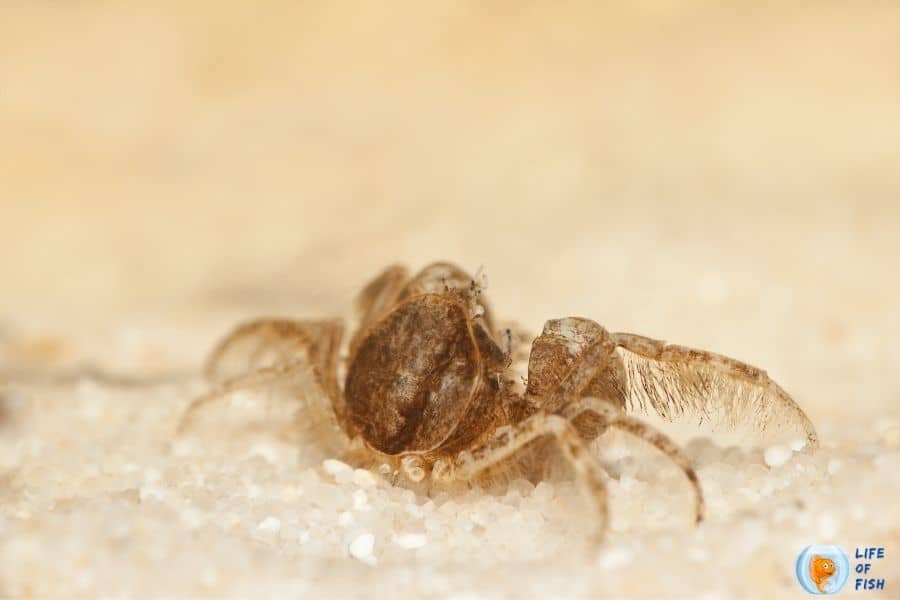
What is Thai micro crab?
Jump To
- 1 What is Thai micro crab?
- 2 How big do Thai micro crabs get?
- 3 Is Thai micro crab aggressive?
- 4 Thai micro crab behavior
- 5 How long do Thai micro crabs live?
- 6 Thai micro crab care
- 7 Thai micro crab breeding
- 8 Special tips
- 9 How to feed Thai micro crabs?
- 10 What fish can live with Thai micro crab?
- 11 Related questions
- 12 One look Care guide
Scientifically named Limnopilos naiyanetri, Thai micro crabs are one of the few fully aquatic crabs in the world.
They are freshwater species that can only be found in the Tha Chin River situated in Thailand.
These crabs are recently introduced to the aquarium hobby and are very rare because of their lack of habitat diversity and difficulty breeding in captivity.
These crabs are brownish-grey (semi-transparent) in color and have long, thin legs. Their entire body, including legs and claws, are covered in small bristles. These bristles help them catch the food by filtering water.
Thai micro crabs have a spider-like appearance. Hence they are considered an exotic species for the aquarium.
Buying Thai micro crabs can be a challenge even online because they are rare. Therefore, the price tag of these species is also high.
How big do Thai micro crabs get?
The average size of Thai micro crab is about 0.4 inches. For crabs, we measure only the diameter of their carapace to point out the size.
With legs, they are much longer than 0.4 inches. But, as the legs are hardly visible, you may not be able to locate these tiny critters often.
Is Thai micro crab aggressive?
No. Thai micro crabs are peaceful crab species. They are actually shy and stay hidden during the day most of the time. Rest assured that these tiny creatures do not harm any other species.
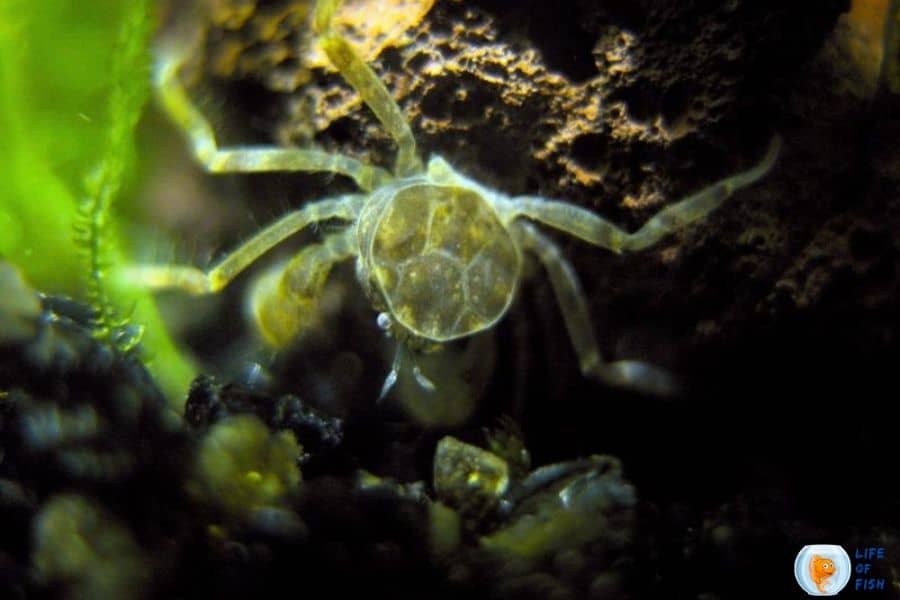
Thai micro crab behavior
Thai micro crabs will live their entire life fully immersed, unlike many other crab types. They are shy, docile species that love to stay hidden most of the time.
These crabs prefer to hide inside the caves, plants, and other decorations where their foods are easily available.
Thai micro crabs are peaceful creatures that prefer to stay in groups. They are social, unlike other crab species.
Thai micro crabs are not territorial, and males will not fight with each other like other crab species. When hiding, you will often see that a group of crabs hide together in the same areas.
These crabs are totally defenseless and try to escape or take cover when threatened or startled.
Thai micro crabs are non-aggressive and will not bother other species in their surroundings.
Because of their small size, they often can not harm other species like shrimps and snails. However, if the creature they are with is smaller than these crabs, they may try to eat them like other crab species.
Thai micro crabs are not highly active species like other crab species. They often stay hidden, but their spider-like appearance and unique acrobatic habits are what make them fun to watch. They will not try to escape the aquarium as these are fully aquatic creatures.
How long do Thai micro crabs live?
In optimum water conditions, these crabs live for about 1 to 1.5 years. As these are small crab species, their life expectancy is much smaller than other crab species.
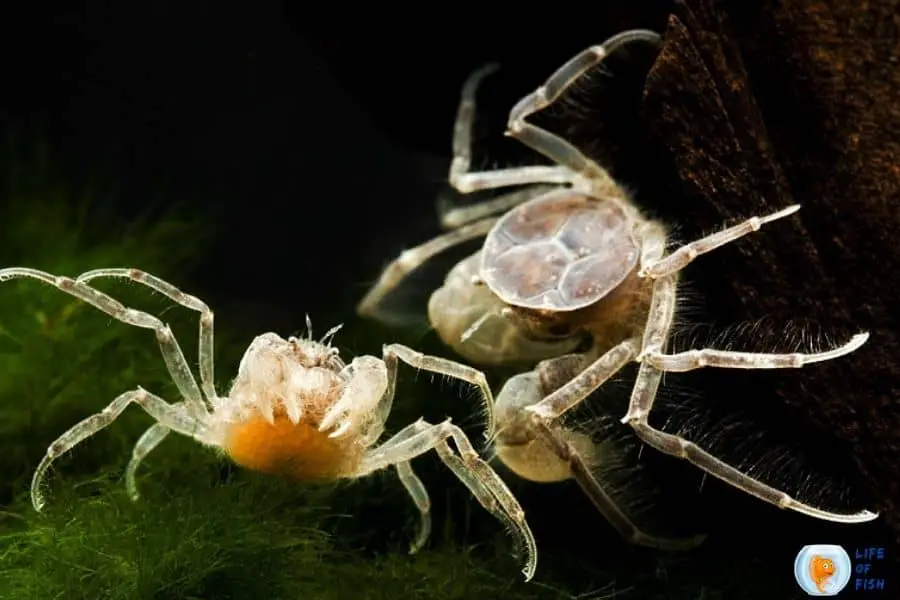
Thai micro crab care
Thai micro crabs are relatively easy to care for species, given that you know exactly how to control water parameters and keep an established, healthy aquarium.
If you are a beginner aquarist with no experience in keeping optimum water conditions, then keeping Thai micro crabs can be challenging.
Thai micro crab size
The diameter of the carapace of Thai micro crabs is about 0.4 inches. That is about 1cm maximum. They may look a bit bigger with the legs, but the legs are hardly visible due to their transparent color.
Thai micro crab tank size
The minimum recommended tank size for Thai micro crabs is 5 gallons. As this is a small crab species, they don’t need much space to thrive.
How many of them should be kept together?
Thai micro crabs prefer to stay in groups. It is recommended to keep at least 5 to 6 crabs in one tank, and you can keep 5-6 crabs in a 5-gallon tank.
Tank setup
Thai micro crabs are freshwater species, so you should set up a freshwater tank with recommended water parameters.
You should fully cycle the tank before introducing your crabs. If the tank is already established with enough biofilm and algae buildup, it is better.
Substrate
These crabs don’t have any particular substrate requirements. So, any shrimp-friendly substrate is fine with them.
However, it is better to use organic substrate like sand as these shrimps need some organic matter to stay healthy.
Lighting
Thai micro crabs do not appreciate bright lights. They prefer to stay hidden in dark places.
Therefore, if you light up your aquarium, you will have to provide a dark corner for them to hang out and feel secure.
Filtration
If you plan to keep these critters in a nano aquarium, a filtration system is required. If you keep them in a large aquarium with enough plantations, you might not need one.
However, to be on the safe side, we recommend you install a filtration system covered with a sponge.
Decorations
Thai micro crabs appreciate many hiding places in their surroundings. So, be sure to decorate your aquarium with rocks, caves, and other decorations.
Plants
These crabs love plants. However, they do not eat plants, but the algae grow on the leaves.
They also scavenge dead leaves. And also, plants provide enough hiding places as well as shade.
So, we recommend adding live floating plants like water hyacinth, Java ferns, anubias, and mosses to your aquarium.
Water quality condition
Thai micro crabs can tolerate different temperatures if the temperature is stable and not fluctuating.
So, if you live in a tropical area or the temperature in your area doesn’t go extreme or doesn’t fluctuate much, you may not need a heater for these species.
However, the optimal water temperature for these species is 72-82 degrees F.
The optimum pH level for these species is 6.5 to 8.0. The water hardness should be about 6-15 dKH.
Since these are very fragile creatures, we recommend adding RO/DI water with remineralizes to be on the safe side.
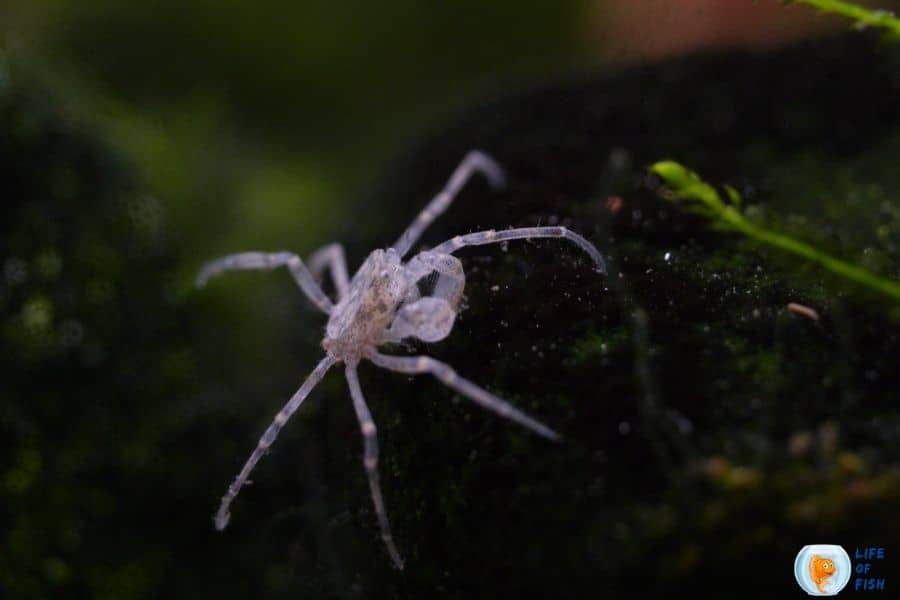
Thai micro crab breeding
Breeding Thai micro crabs in captivity are extremely difficult. There are reports on hatched eggs, even formed baby crabs, but all of those haven’t survived for long.
Hobbyists report that the offspring don’t survive for more than nine days in captivity.
Therefore, experts believe that the reason for this is not providing their optimum breeding parameters.
And to this day, nobody has found out the real reason, and everyone is trying to figure out a way to breed these creatures in captivity. This is perhaps the main reason these crabs are so rare that you can’t even find them online.
Thai micro crab male or female identification
Due to the small size of these crabs, sexing the crabs is almost impossible. And also, You may not be able to identify the crab’s sex via physical examination as they are fragile enough to get hurt if we hold them.
However, if the crab is positioned somewhere that you can see the underbelly, you may be able to distinguish male from female.
For this, you need a magnifying glass. Males have a small tapering bottom flap, while females have a broader bottom flap.
However, if the female crab you are watching is pregnant and carrying a cluster of eggs or larvae, you can distinguish the female from the male, but that is highly unlikely in an aquarium.
Identify pregnant Thai micro crab and pregnancy stages
Once the female is sexually matured, it spawns with the male. Reproduction is via internal fertilization—the male transfers sperm from the gonopod to the female.
Once the eggs are fertilized, the female then carries a cluster of up to 200 fertilized eggs in the abdomen (pleon).
About 70 eggs hatch, and interestingly, the larvae don’t get released into the environment right away.
Instead, the female crab holds the larva inside her pleon for a few more weeks. When the babies end their larvae stage and become mini Thai micro crabs, the female releases them into the environment.
Thai micro crab breeding
Breeding Thai micro crabs is an unsuccessful effort as many experts tried several methods already.
Their optimal breeding environment can not be replicated in captivity. There is an unidentified ingredient in their natural habitats that helps in successful breeding.
Some believe it is a particular nutrient that is present in their habitats but lacks in aquariums.
Others believe that it is because these crabs are like any other crab that deposit eggs on land in their natural habitats.
But, as we said before, these are fully aquatic species. So, they don’t go to the land for any reason.
Exports reported that micro crab babies are attracted to lights. So, if you ever breed these species, be sure to install proper lighting in the breeding tank.
But, unfortunately, the survival rate of these babies is near zero. Therefore, we do not recommend breeding Thai micro crabs at home.
How many babies do they have?
Thai micro crabs usually have around 70 fully grown babies in one breeding season.
The females deposit about 200 eggs in her abdomen (speon) but only about 70 babies will make it. But, unfortunately, these babies will live only about a week in captivity.
Thai micro crab fry care
Thai micro crab babies are attracted to lights. So, provide good lighting in your aquarium. They feed on biofilm and algae.
So, you must ensure that your tank is established enough with biofilm and algae growth.
The male crab tends to eat these babies, so you will have to remove the adults from the breeding tank until the babies grow up.
You should replace the filters with sponge filters to avoid sucking up babies. But, despite the highest quality water condition you provide, unfortunately, they do not make it more than nine days in aquariums.
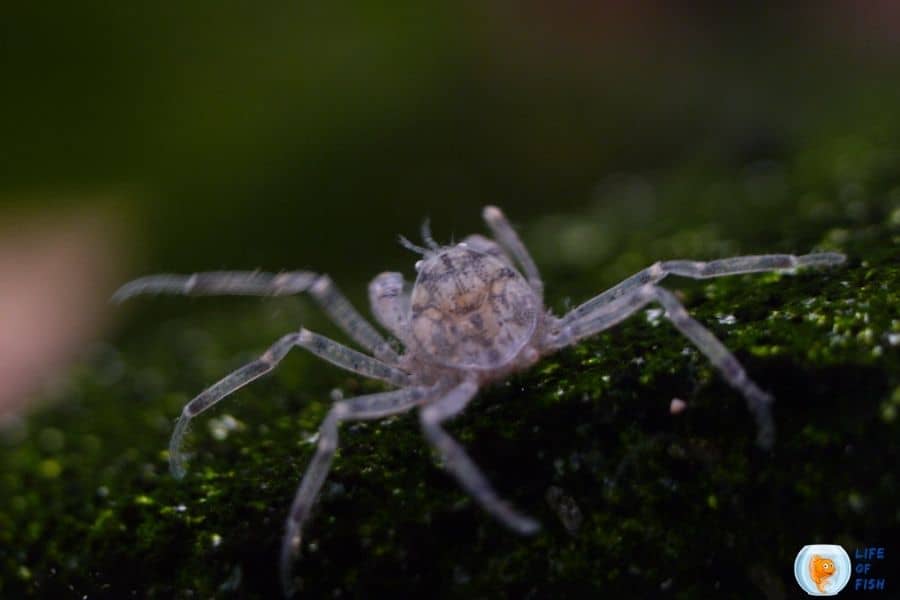
Special tips
- Do not add these crabs to a large aquarium, as you may not see them again.
- Thai micro crabs are sensitive to poor water conditions. So, good filtration is essential.
- If the tank has a tube of any kind, fill them with a sponge as these critters may go inside the tubes and stuck themselves.
- When choosing the substrate, choose a color that contrasts the greyish-brown color of these crabs.
- If possible, always avoid netting these creatures. These crabs are so fragile that they may lose their legs or have any other damage while handling. The limbs regrow after a molt or two, but you don’t want to harm or stress them this way.
How to feed Thai micro crabs?
Thai micro crabs are omnivore scavengers. They typically scavenge for food using their hairs and legs, and claws throughout the day.
They also feed on plant detritus and algae. If your aquarium is well established and has enough biofilm and algae, you might not need to feed these critters.
But, if you feel the food in your aquarium is not enough, you can feed them with powdered plant-based shrimp food, sinking algae wafers, Hearty live or frozen food, or any other sinking powdered fish food once per day. Once per two days might also be enough.
Note: Thai micro crabs are not aggressive. So, they do not hunt for food. Instead, they will eat whatever they find.
If you keep dwarf shrimp with these species, the shrimp will eat most of the food. Therefore, ensure that these species also get a fair share when you are feeding.
What fish can live with Thai micro crab?
Thai micro crabs are a very peaceful species. So they need a peaceful community to live in.
They are defenseless creatures that hide all the time. So, you should avoid aggressive species and carnivore fishes.
Never put any other crab species or crayfish with Thai micro crabs. They will surely have these crabs for dinner.
Some compatible tank mates are,
- Otocinclus catfish
- Nerite Snails
- Small schooling fish
- Pygmy Corydoras
- Mystery Snails
- Ramshorn Snails
- Zebra Danio
- Ghost Shrimp
- Neocaridina shrimp
Do not add species like below with these crabs.
- Other crabs
- Goldfish
- Cichlids
- Crayfish
- Angelfish
- Large catfish
- Tetras
Related questions
Will Thai micro crabs breed?
Thai micro crabs successfully breed only in their natural habitats. Hobbyists tried several ways to breed them in captivity.
But none of them succeeded. The experts are still trying to find a way to breed them in captivity successfully.
But, they still couldn’t find the optimum water condition for breeding them. Therefore, these crabs are rare and expensive in the aquarium trade.
Can Thai micro crabs live with shrimp?
Thai micro crabs can live with Neocardina, and ghost shrimp as the water conditions of these species somehow match with the Thai micro crabs.
But, they may not be able to live with dwarf shrimps because dwarf shrimps always outcompete these crabs for food.
Can Thai micro crabs live with bettas?
Some aquarists had success pairing bettas with these species with enough hiding places, but some didn’t.
As these are expensive and rare crabs, we don’t recommend keeping these two species together. Bettas are aggressive and territorial fish species.
So, there is a risk that they will attack these tiny, fragile crabs to death.

One look Care guide
| Scientific name | Limnopilos naiyanetr |
| Common name | Pill-box crabs, False Spider crabs, Thai Micro crabs |
| Care level | Medium |
| Native to | Thailand |
| Type | crabs |
| Color | Light grey with patterns |
| Tank size | 5 gallons minimum |
| Preferred temperature | 72-82 degrees F |
| Other water parameters (ammonia ,ect) | pH 6.5-8.0hardness- 6-15 dKH |
| Preferred salinity | None. Freshwater species. |
| Size of the Thai micro crab | 0.4inches (1cm) carapace |
| Life span | 1-1.5 years |
| Temperament | Peaceful |
| Recommended tank mates | Small peaceful species. No crabs, crayfish, or aggressive and carnivore species. |
| Preferred food | Biofilm, algae, leftover food, Omnivore scavengers |
| Feeding frequency | Once per day or once per two days |
| Breeding | Very difficult |
Read Next: Sulawesi Shrimp (Caridina dennerli) Ultimate Care Guide
